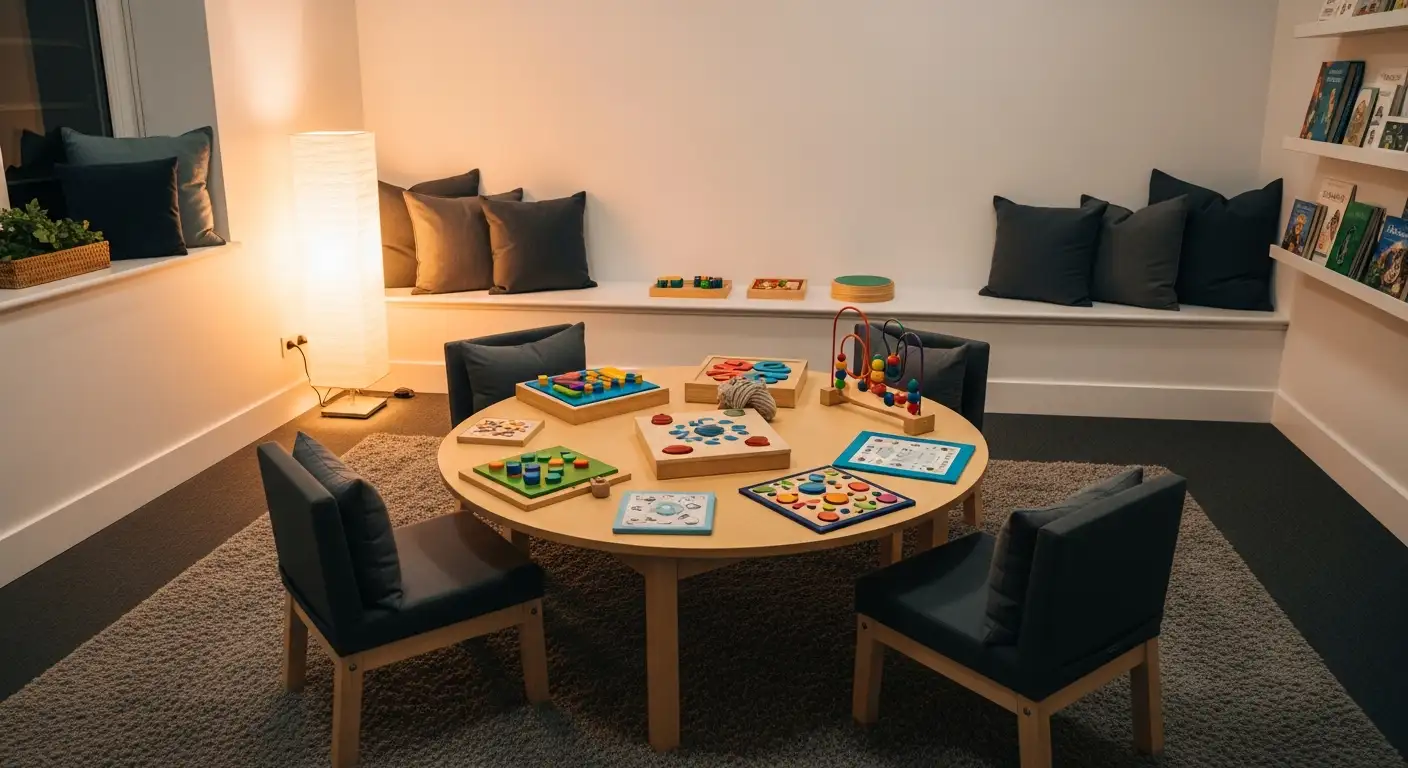
Understanding ABA Therapy for Autism
What is ABA Therapy?
ABA Therapy, or Applied Behavior Analysis Therapy, is a scientifically proven approach that effectively treats individuals with autism spectrum disorder (ASD) and other developmental disorders. The primary focus of ABA therapy is on modifying behavior through systematic interventions, which are designed to teach and reinforce positive behaviors while reducing challenging ones.
ABA therapy is tailored to each child’s unique needs and preferences, providing positive reinforcement in daily activities. This method helps strengthen desirable behaviors while decreasing negative behaviors. Positive reinforcement is a crucial strategy in ABA therapy, where children receive rewards for displaying positive behavior changes. These rewards can encompass praise, access to preferred activities, toys, or even watching videos.
How ABA Therapy Benefits Children
The benefits of ABA therapy extend beyond mere behavior modification. It provides a structured environment where children can learn and grow. The following table summarizes some key benefits:
BenefitDescriptionImproved CommunicationEnhances verbal and non-verbal communication skills, allowing for better social interactions.Social Skills DevelopmentEncourages positive interactions with peers, helping children build relationships.Increased IndependenceTeaches daily living skills, enabling children to perform tasks independently.Reduced Challenging BehaviorsEffectively diminishes undesirable behaviors through positive reinforcement.Personalized LearningPrograms are tailored based on the child's specific needs, promoting effective learning.
Therapists have utilized ABA techniques to aid children with autism and related developmental disorders since the 1960s [3]. A total of 14 randomized control trials involving 555 participants have demonstrated the effectiveness of ABA in managing symptoms of children diagnosed with ASD. This evidence positions ABA therapy as a reliable choice for parents seeking ABA therapy for autism skill services.
Personalized ABA Therapy Programs
Personalized ABA therapy programs are essential in addressing the unique needs of children diagnosed with autism. These programs utilize tailored techniques and one-on-one sessions to ensure effective skill development and behavioral improvement.
Tailored Techniques and Strategies
The foundation of personalized ABA therapy lies in its tailored techniques and strategies, which are specifically designed to meet the individual needs of each child. These strategies include prompting, reinforcement, and shaping to encourage desired behaviors while reducing problem behaviors. According to Adina ABA, ABA therapy is a scientifically proven approach that focuses on modifying behavior through systematic interventions.
The customization of these techniques is vital. Each child benefits from methods that resonate with their preferences and daily activities, allowing for positive reinforcement in meaningful contexts. This attention to individual differences helps strengthen positive behaviors and decrease negative ones, fostering meaningful progress in daily life.
TechniqueDescriptionPromptingProviding cues to encourage desired behaviorsReinforcementRewarding positive behaviors to increase their occurrenceShapingGradually guiding behavior to desired outcomes
One-on-One Therapy Sessions
One-on-one therapy sessions are a hallmark of effective ABA therapy. During these sessions, a trained therapist works directly with the child, implementing specific techniques tailored to their unique needs. This individualized attention allows for immediate feedback and adaptation of strategies based on the child's responses.
Research indicates that parents should engage with a Board Certified Behavior Analyst (BCBA) for caregiver collaboration and family training, dedicating between 30 minutes to one hour each week. This collaboration helps to reinforce the skills learned during therapy sessions in everyday settings.
In addition to direct therapy, the ongoing involvement of family members is crucial for reinforcing the strategies discussed during sessions. Such partnerships enhance the overall effectiveness of the therapy, making skill development more sustainable in the long term.
Through personalized techniques and dedicated one-on-one sessions, ABA therapy aims to support children in developing essential skills while promoting overall growth and improvement in various areas of their lives. For more information on the benefits of ABA therapy, explore our articles on ABA therapy for autism treatment services and ABA therapy for autism behavioral development.
Goals and Focus Areas of ABA Therapy
ABA therapy for autism skill services focuses on developing essential skills in children diagnosed with autism. A significant part of these services involves enhancing communication and socialization, which are crucial for successful interaction and integration in everyday life.
Communication and Language Skills
Communication skills encompass both expressive and receptive language abilities. ABA therapy aims to improve these skills through personalized goals based on individual assessments carried out by therapists. By employing various techniques, such as reinforcement and modeling, children can learn to express their needs and understand language better.
Communication Goal TypeFocus AreasExpressive LanguageEncouraging verbal communication and using gestures to convey feelings and needs.Receptive LanguageEnhancing understanding of spoken language and following directions.Non-verbal CommunicationTeaching the use of visual supports, sign language, or alternative communication devices.
Research indicates significant improvement in communication skills among children with autism who engage in ABA therapy. Studies have shown that ABA-based interventions yield positive outcomes regarding communication, expressive language, and overall social interaction capabilities.
Social Interaction and Relationships
Social skills are another vital area of focus in ABA therapy. The ultimate goal is to foster appropriate interactions and relationships with peers and family members. ABA therapy addresses social skills through targeted interventions that teach children to recognize social cues, engage in conversations, and build friendships.
Social Skills Goal TypeSpecific Focus AreasPeer InteractionTeaching sharing, turn-taking, and cooperative play with peers.Understanding Social CuesIdentifying facial expressions and body language.Relationship BuildingEncouraging forming friendships and understanding social norms.
Studies indicate that children with autism exhibit significant improvement in socialization skills after participating in ABA programs. These enhancements contribute to creating meaningful relationships and better integration into social settings.
Parents looking to enhance their child's communication and social skills through ABA therapy should seek programs that provide personalized and evidence-based approaches. More information can be found on aba therapy for autism services and related interventions on aba therapy for behavioral programs.
Family Involvement in ABA Therapy
Family involvement is a crucial component of successful ABA therapy for children with autism. By engaging parents and caregivers in the therapeutic process, they can contribute significantly to their child's progress and overall well-being.
Importance of Family Support
The role of family support cannot be overstated. Families who actively participate in their child's ABA therapy often see better outcomes. Studies have shown that ABA therapy success rates for autism are upwards of 90%, with many children developing skills that are equal to their peers. Parents who are married or partnered are more likely to ensure their children stay in therapy for longer periods, indicating that stable family support leads to commitment in pursuing habilitative services.
One effective way families can contribute is by dedicating time for caregiver collaboration and training. Parents are encouraged to spend around 30 minutes to one hour each week with their BCBA (Board Certified Behavior Analyst) to discuss strategies and receive guidance on how to reinforce learning at home [2].
Collaboration Between Therapists and Parents
Collaboration between therapists and parents is essential for fostering a cohesive approach to care. ABA therapy sessions are typically conducted one-on-one with a trained therapist who applies specific techniques tailored to the child's needs. This creates an effective learning environment, but it can be further enhanced by consistent communication between families and therapists.
At centers like ATG, family involvement is emphasized, and training is provided for parents and caregivers. This allows them to support and reinforce desired behaviors at home. Effective collaboration helps parents feel empowered and more confident in implementing the strategies their child learns during therapy.
By engaging in the ABA process and maintaining open lines of communication with therapists, families can play a pivotal role in their child's success. For more information on available programs, parents can explore our resources on aba therapy for autism treatment services and aba therapy for autism behavioral development.
Challenges in ABA Therapy
While ABA therapy provides valuable support for children with autism, several challenges can arise during the process. Understanding these challenges can help parents better prepare for their child's journey in ABA therapy.
Managing Progress and Expectations
Progress in ABA therapy can often be gradual. Each child develops skills at their own pace, and this variability can sometimes be difficult for parents to manage. It is important for families to maintain patience and set realistic goals. Celebrating small victories can strengthen motivation and keep spirits high during the therapy journey.
Clear communication between parents and therapists is essential. Open discussions about expectations can enhance morale and ensure all parties are aligned on goals. By embracing the process and recognizing that progress may vary, families can foster a more positive experience.
Example GoalsExpected TimeframeActual ProgressImprove communication skills3 months2 monthsIncrease social interactions6 months5 monthsDevelop daily living skills4 months6 months
Overcoming Financial Barriers
Financial and insurance constraints often present challenges in accessing ABA therapy. The costs associated with therapy can be significant, and navigating insurance coverage can be daunting. Many families find support through their service providers, like ATG, who assist in exploring funding options and financial assistance avenues.
For families seeking therapy, it's crucial to research insurance policies to understand coverage options for ABA therapy for autism services. Some centers provide assistance with the insurance process, which can alleviate some of the financial burdens. Understanding available resources and support can help families access the necessary services without the added stress of financial worries.
Success and Effectiveness of ABA Therapy
ABA therapy has shown remarkable effectiveness in supporting children diagnosed with autism. Evidence-based approaches and positive outcomes indicate why many parents consider it the go-to option for skill services.
Evidence-Based Approaches
ABA therapy utilizes evidence-based practices, which are proven methods that have undergone extensive research and trials. Renowned organizations such as the American Psychiatric Association and the American Psychological Association endorse ABA therapy. Studies suggest that significant improvements in IQ, verbal skills, and social functioning occur in individuals with autism who receive ABA services before they turn four years old.
ApproachDescriptionEarly InterventionServices provided before age 4 show the greatest benefits.Intensive TherapyLong-term engagement results in better skill development.Customized ProgramsTailored techniques that cater to the child's specific needs.
Positive Outcomes and Success Rates
The success rates associated with ABA therapy for autism are impressive, often reported to be upwards of 90%. A considerable number of children who undergo ABA services develop skills comparable to their peers. More than 20 studies indicate that intensive, long-term therapy utilizing ABA principles leads to gains in various critical areas such as intellectual functioning, language development, and social skills.
StatisticOutcomeSuccess Rate>90% report significant benefitsSkill DevelopmentMany children achieve peer-level skillsAreas of ImprovementIntellectual, language, daily living, social
The UCLA Young Autism Project model further emphasized the impact of ABA therapy, revealing that a significant percentage of children engaged in intensive ABA treatment reached normal intellectual and educational functioning. This information underlines the effectiveness and transformative potential of ABA therapy for families seeking aba therapy for autism services.
For parents considering ABA therapy as an option, understanding its evidence-based practices and inherent success rates provides a solid foundation for making informed choices about their child's development.
References
[2]:
[3]:
[4]:
[5]:
[6]:
[7]:











